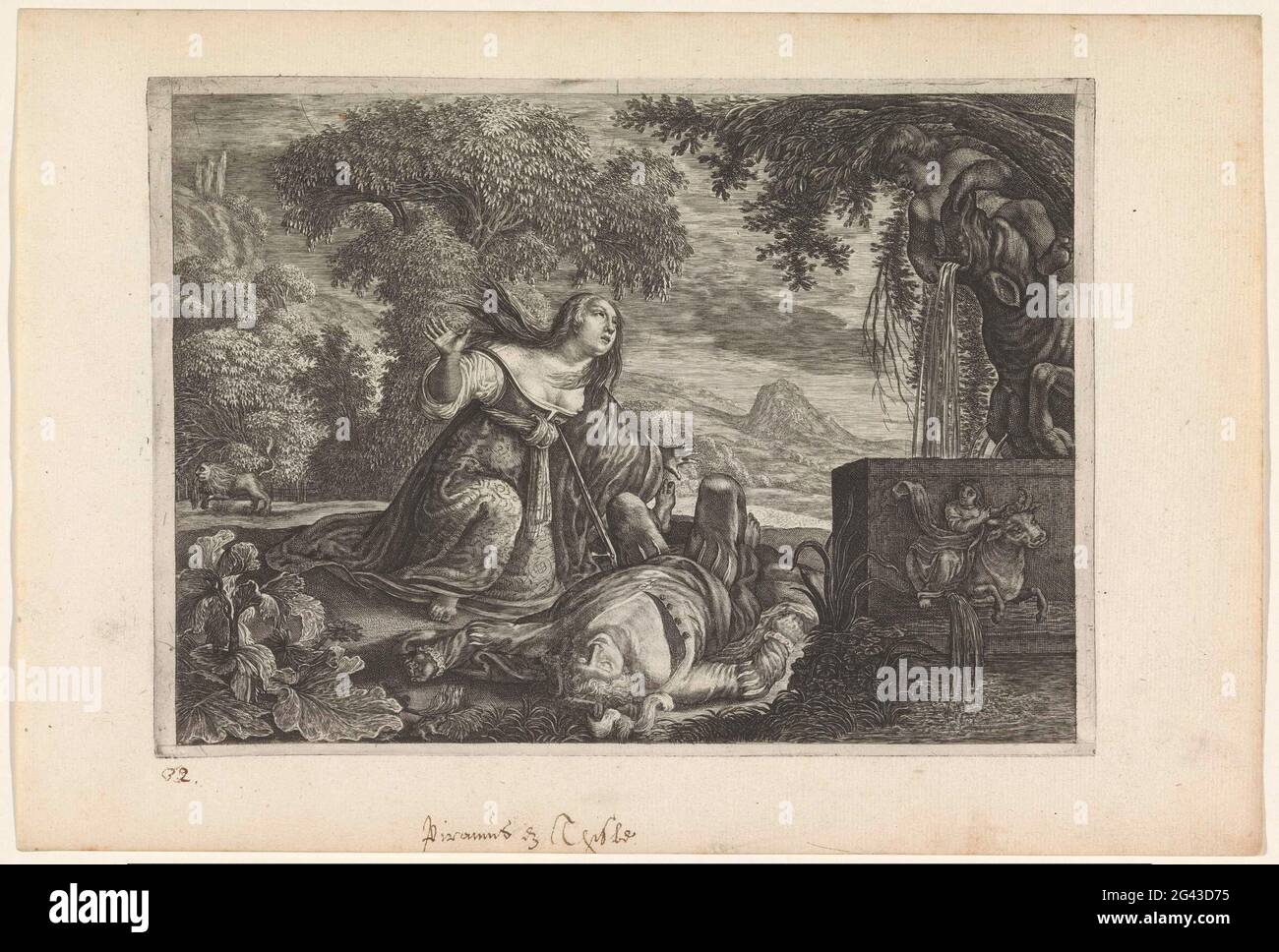Before Romeo and Juliet, there was Pyramus and Thisbe: A Babylonian love story whose tragic end echoes through millennia of literature. Separated by a wall, united by love, destroyed by misunderstanding: The myth of Pyramus and Thisbe exposes the fragility of love in the face of societal barriers and miscommunication. Thisbe, more than just Pyramus’s beloved, emerges as a symbol of female agency in a patriarchal world, defying societal constraints in pursuit of love.
Whispers Through the Wall: A Love Divided
In ancient Babylon, where feuding families erected walls thicker than any rampart, two young souls, Pyramus and Thisbe, found love blooming amidst the thorns of their parents’ hatred. He, lauded as the most handsome youth, and she, the fairest maiden of the East, resided in adjoining houses, their families’ animosity a constant, palpable tension. Ironically, the very wall meant to divide them became their lifeline, a secret passage for whispered words and stolen moments. A small crack, a flaw in the imposing structure, became their sanctuary, a symbolic defiance against the societal pressures that sought to keep them apart. This clandestine communication, much like a modern-day text message but fraught with far greater risk, fueled their forbidden romance and intensified their longing for a future where their love could flourish freely. You can almost imagine them huddled against the cool stone, their voices barely audible, sharing dreams and promises under the cover of darkness. Thisbe, in her courage to pursue love in the face of such opposition, stands as a testament to female agency in a world that likely sought to constrain her.
A Tryst Under the Mulberry Tree: A Fateful Misunderstanding
Desperate to escape their families’ animosity, Pyramus and Thisbe plotted a secret rendezvous at Ninus’ tomb, beneath a mulberry tree laden with snow-white berries. Thisbe, driven by anticipation and a heart full of hope, arrived first. But fate, in the form of a lioness fresh from a kill, intervened. Terrified, Thisbe fled, her veil snagged and left behind, a tragic detail that would seal their fate. The image of the lioness pawing at the blood-stained veil sets the stage for the devastating misunderstanding that follows.
Pyramus, arriving later, discovered the blood-stained veil and was immediately consumed by despair. The logical leap, though tragically flawed, was immediate: he believed Thisbe had been slain. Overcome by grief, he drew his sword and ended his life, his blood staining the pristine white mulberries a deep crimson. This impulsive act, fueled by a moment of profound sorrow and misinterpretation, underscores the intensity of his love and the devastating consequences of assumptions.
Thisbe, having escaped the lioness, returned to the mulberry tree, her heart soaring with the anticipation of their reunion. But the scene that awaited her shattered her world: Pyramus lay lifeless beneath the tree, the berries now a stark reminder of his sacrifice. Unable to bear the pain, she took her own life with Pyramus’s sword, joining him in a tragic double suicide. This act of self-sacrifice, often overshadowed by Pyramus’s grief, emphasizes Thisbe’s equal devotion and the utter devastation of their shared loss. Exploring her perspective allows us to see not just a passive victim, but an active participant in this tragic love story.
The Mulberry’s Crimson Stain: A Legacy of Love and Loss
The gods, witnessing this heartbreaking spectacle, were said to be moved by the lovers’ devotion. In some versions of the myth, they transformed the white mulberries to a deep red, forever commemorating Pyramus and Thisbe’s love and sacrifice. The mulberry tree, forever stained crimson by the lovers’ tragic demise, becomes a poignant symbol of love’s enduring power even in death. This divine intervention elevates the mulberry tree beyond a simple backdrop; it becomes a symbolic representation of their eternal love, a poignant reminder of a passion that defied societal barriers but ultimately fell victim to a cruel twist of fate.
Echoes Through Time: From Ovid to Shakespeare and Beyond
The myth of Pyramus and Thisbe, most famously recounted in Ovid’s Metamorphoses (written around 8 AD), has resonated through literature for centuries. While Ovid’s version solidified the story in Western literature, it’s likely that earlier iterations existed, perhaps originating in Cilicia, where the Pyramos River (now Ceyhan River) flows. This suggests that the story, passed down through oral traditions, may have evolved over time, adapting to different cultures and beliefs. Current research in ancient literature and oral traditions may one day uncover more about these earlier versions, but for now, much remains shrouded in the mists of time.
The story’s influence is perhaps most evident in Shakespeare’s Romeo and Juliet. The parallels between the two tales – feuding families, secret meetings, and the devastating consequences of misunderstandings – are undeniable. Shakespeare, however, reimagines the narrative in A Midsummer Night’s Dream through a comedic lens, with the weaver Bottom hilariously portraying Pyramus in a “play within a play.” This comedic interpretation, while undeniably entertaining, raises questions about how humor can alter our perception of ancient stories. Does laughter diminish the tragedy or make these timeless tales more accessible to modern audiences?
Deconstructing “Pyramus”: A Name Lost to Time
The name Pyramus, likely derived from the Ancient Greek word “pûr” meaning “fire” or “blaze,” adds another layer of symbolism to the story. This fiery etymology suggests a passionate, all-consuming love that ultimately burns too brightly and too quickly. The name itself seems to foreshadow the tragic events, hinting at the destructive potential of unchecked emotions.
Interestingly, while Thisbe has enjoyed a minor resurgence in recent times, Pyramus has faded into obscurity. Several theories attempt to explain this disparity. Some suggest the name’s strong association with tragedy makes it less appealing, while others point to Shakespeare’s comedic portrayal as having diluted the romanticism of the original myth. Whatever the reason, selecting Pyramus as a name today would be a unique choice, a bold nod to a classic tale of love and loss.
The Enduring Power of a Myth: Lessons in Love and Loss
The story of Pyramus and Thisbe isn’t just a relic of the past; it continues to resonate with readers today because it speaks to timeless human experiences. The myth explores themes of love, loss, societal constraints, and the devastating power of miscommunication. It serves as a cautionary tale, reminding us that even the strongest love can be fragile in the face of prejudice and misunderstanding. By examining the choices made by Pyramus and Thisbe, we can explore the complex interplay of fate and free will, prompting reflection on how our own assumptions and actions shape our lives. The enduring power of the myth lies in its ability to prompt these questions and offer a space for contemplation on the human condition.
- SYBAU See You Baby Meaning: Gen Z Slang Evolves - July 1, 2025
- Unlock Your Inner Youth: Lifestyle Secrets for a Vibrant Life - July 1, 2025
- Decode SYBAU Meaning: Gen Z Slang Explained - July 1, 2025






